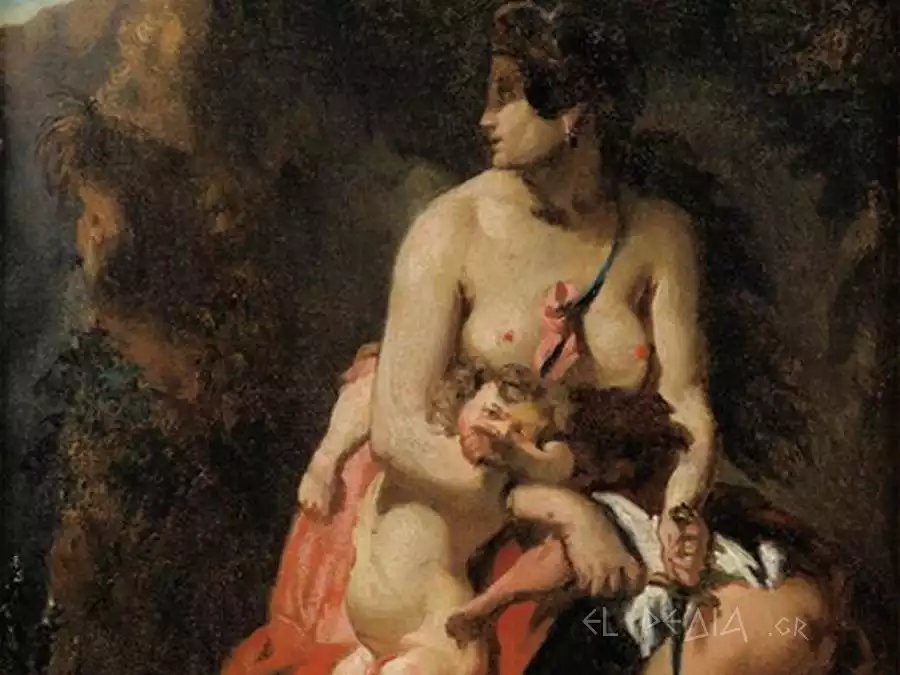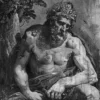
The myth of Medea, one of the most complex figures in Greek mythology, begins in ancient Colchis, on the eastern shores of the Black Sea. As the daughter of King Aeëtes and the Oceanid Idyia, Medea had divine ancestry and exceptional magical powers, which she had acquired as a priestess of Hecate.
Her life changed dramatically with the arrival of the Argonauts and Jason in Colchis, in search of the Golden Fleece. Under the influence of Hera and Aphrodite, Medea fell in love with Jason and helped him overcome the deadly trials set by her father. Betraying her family, she participated in the theft of the Fleece and fled with the Argonauts, even going so far as to kill and dismember her brother Apsyrtus to delay the pursuit.
After wandering, the couple settled in Corinth, where they lived for ten years and had two sons. Their happiness was interrupted when Jason decided to marry Glauce, the daughter of King Creon. This betrayal led Medea to a terrible revenge: she killed Glauce and Creon with poisoned gifts and then killed her own children to cause Jason the ultimate pain. She fled to Athens with the chariot of her great-grandfather Helios, where she later married King Aegeus.
The Myth of Medea
The mythical narrative of Medea unfolds in the depths of ancient Greek tradition, with its roots reaching back to prehistoric Colchis, the present-day region of Georgia. Medea, as the daughter of King Aeëtes and granddaughter of Helios, held a unique position in the mythological pantheon, combining royal lineage with the mysterious powers of magic.
Her initial presence in the myth is characterized by her deep knowledge of the secrets of nature and the healing properties of herbs, knowledge she had acquired as a priestess of Hecate. In the kingdom of Colchis, the young princess lived a life dedicated to the worship of the gods and the practice of her magical powers, until the fateful arrival of the Argonauts.
Her acquaintance with Jason was the decisive turning point in her story. In a remarkable display of the complexity of her character, Medea found herself torn between her devotion to her paternal home and the irresistible love and passion she felt for the foreign hero (Sirola). This internal conflict, which would later evolve into one of the most tragic stories of ancient literature, marks the beginning of her adventure.
Her decision to help Jason acquire the Golden Fleece marked the beginning of a series of events that would lead her to betray her family and flee her homeland. Her magical abilities and exceptional intelligence proved crucial to the success of Jason’s mission, as she provided him with the means to overcome the seemingly insurmountable trials set by King Aeëtes.
The complexity of Medea’s character is reflected in the various versions of the myth that have survived to this day. Sometimes she is portrayed as a woman possessed by uncontrollable passions and other times as a tragic figure who falls victim to the circumstances and social conventions of her time. Her story serves as a timeless reminder of the delicate balance between love and duty, passion and reason, personal desire and social imperatives.
Medea in the Argonautic Expedition
Medea’s participation in the Argonautic expedition is a pivotal point in the development of her myth. The journey of the Argonauts to Colchis, under Jason’s leadership, aimed to retrieve the Golden Fleece, a mythical object guarded in the kingdom of Aeëtes.
Medea’s first meeting with Jason took place at the sanctuary of Hecate, where the young priestess used to perform her mystical rituals. At this point in the narrative, the goddess Hera plays a decisive role, as in collaboration with Aphrodite, she implants in Medea’s heart an irresistible love for Jason. The decision of the gods to intervene in the fate of the young princess determines the subsequent development of events in a way that highlights the tragic fate of the heroine (Burnett).
Within the framework of the trials set by Aeëtes for Jason, Medea emerges as a crucial factor in the success of the mission, as her knowledge of magical art and her familiarity with the secrets of herbs prove essential for overcoming the seemingly insurmountable obstacles faced by the hero. The preparation of the magical oil that protected Jason from the fire of the bronze bulls, the concoction of the sleeping potion that put the dragon guarding the Golden Fleece to sleep, and the detailed instructions she provided for dealing with the native warriors are characteristic examples of her decisive contribution.
Medea’s decision to leave her paternal home and follow Jason to Greece marks a deep rupture with her past and the beginning of a new, adventurous journey. The flight from Colchis is accompanied by dramatic events, such as the murder of her brother Apsyrtus, an act that reveals the depth of her devotion to her love for Jason, but also the tragic dimension of her character.
During the return journey, Medea continues to protect the Argonauts with her magical powers, facing dangerous creatures and natural obstacles. Their route includes stops at various islands and coastal areas, where Medea leaves her mark on local mythology and tradition.
The Tragedy in Corinth
The settlement of Medea and Jason in Corinth marks the beginning of the most tragic period of the myth. Their ten-year stay in the city is initially characterized by prosperity and social recognition, with the couple having two sons and enjoying a high position in Corinthian society.
The upheaval occurs when Jason, turning towards consolidating his political position, decides to marry Glauce, the daughter of King Creon. This betrayal triggers a chain of events that lead to total destruction. The magical power of Medea turns into an instrument of revenge, as she devises a plan for the complete destruction of her former husband (Newton).
The psychological dimension of the tragedy is revealed through Medea’s internal dialogue, as she faces the most painful decision: the killing of her children as a means of revenge against Jason. At this point, the narrative acquires universal dimensions, as the conflict between maternal love and the need for revenge reflects the timeless struggle between emotion and reason.
The execution of Medea’s plan begins with the sending of poisoned gifts to the new bride. A veil and a golden crown, imbued with deadly poison, cause the horrific death of Glauce and her father Creon, who rushes to save his daughter. This scene is a characteristic example of Medea’s prowess in using her magical powers.
The climax of the tragedy comes with the killing of the children by their own mother, an act that marks the ultimate rupture with human nature and social order. The appearance of Helios’ chariot, which takes Medea away from Corinth, adds a metaphysical dimension to the tragedy, underscoring the heroine’s divine ancestry and the transcendence of human limits.
The Enduring Artistic Legacy of Medea
Medea’s myth continues to hold a powerful sway in the realms of art and literature. From the ancient world to our own, she has served and continues to serve as a potent inspiration for an almost infinite number of artistic expressions, each exploring, in its own way, the many different facets of her fascinatingly complex persona. Or perhaps we should say personas, given her all-too-recent revival in popular culture, which now includes quite a large number of her chillingly potent variants from whom we the living can expect nothing but death and destruction (among the many thanks we owe to her for the establishment of the “feminine,” not to mention “motherly,” as a cozy but lethal trap).
In the world of ancient vase painting, the image of Medea conformed to certain iconographic conventions. She is often shown as a priestess from the East, set off by her extraordinary clothing and the telling objects that denote her magical abilities. What these images mostly capture are moments from Medea’s life that are most likely to be recognized by an audience familiar with her too well-known story. The representations are not what you would call rare and do not exhibit much in the way of variation. They tend to stick closely to the same sequence of events and even to the same poses, which makes them look rather like places where an artist would hit “copy” or “paste” on a computer keyboard in order to replicate an earlier image.
As we progress into the Hellenistic and Roman epochs, the artistic depiction of Medea takes an overtly pronounced turn in a single direction: toward the not-so-simple, not-so-straight maternal aspect of her mythic character. No longer simply a figure of revenge, Medea at this moment takes on the monomythic persona of a tragic heroine with deeper complexities and a much larger set of archetypal plights that she resolutely traverses. Hours of toil under the artistic brush have turned her from a somewhat crude mama-bear figure into a psychologically nuanced tragic heroine. That shift and its associated aspects—most profoundly, her innermost confusion about life-choices and their appearance in pathos-laden frescoes discovered in Pompeii and Herculaneum—are what I want to underline in this lesson.
The presence of Medea in world dramaturgy has imprinted itself onto audiences forever. Euripides’ magnificent tragedy has become virtually a touchstone for the theatrical adaptations that have followed it. They run the gamut from Seneca to very recent, and quite notable, productions. Often on the stage—but also in the movies and in opera—Medea seems to become something much more significant than her mythical, or even tragic, historical origins. She is frequently given the breastplate of a symbol. She is a fierce icon of something.
Medea’s figure captivates and inspires contemporary global artists. Her presence in painting, cinema, and literature is a testament to the relevance of her myth. Modern creators across media reinterpret her tale into the tissue of contemporary politics and the media, mining her story for the marrow of melodrama. Shrewdly, they bring to light new dimensions of her complex personality and the enduring power of her narrative.
Medea: A Timeless Symbol
The myth of Medea remains a timeless symbol of the conflicts that characterize human existence. Her multifaceted personality, combining priestly knowledge with maternal love and the passion for revenge, reflects the internal contradictions of human nature. Her story continues to provoke reflection on the limits of human behavior and the consequences of our actions.
Medea’s legacy in world literature and art is a testament to the timeless relevance of her myth. Contemporary readings of the myth continue to highlight new aspects of her personality, making her a symbol of female emancipation and resistance to social injustice.
elpedia.gr
Bibliography
Newton, RM. “Medea’s Passionate Poison.” Syllecta Classica (1989): 13-27.
Burnett, A. “Medea and the Tragedy of Revenge.” Classical Philology (1973): 1-24.
Sirola, R. “The Myth of Medea from the Point of View of Psychoanalysis.” The Scandinavian Psychoanalytic Review (2004): 12-23.

